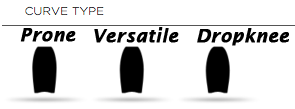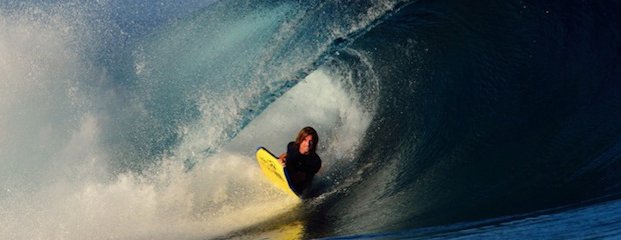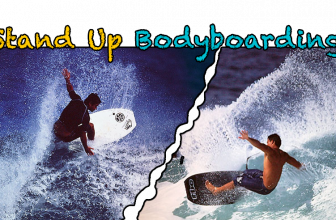
If you are considering whether or not to buy a custom bodyboard or a stock one, you’ve come to the right place because we will be breaking down the differences and then diving deep into the options for a custom board.
You have to know you exactly what you want when ordering a custom board (we teach you the basics below so we got you covered) vs. a regular stock bodyboard that is already made and you just pick it out.
If you are brand new to bodyboarding and really don’t have a clue, you should definitely get a regular board from a bodyboard shop or website. But if you have been bodyboarding for a while and ready to step up your game and want to get your first custom board, you should do it!
Custom boards are great because you can order exactly what you want, figure out what you like and don’t like, and then order another custom down the line until you have really narrowed down and refined your board to the point where it is perfect. Another awesome thing about customs is that you can get really use to a certain shape.
All the Pro’s do it, they all get custom boards, experiment and tweak things but also they have their own shape. Many/most pro bodyboarders have their own signature model board. And here’s the thing, they usually don’t change their overall shape very much, which allows them to really get used to a board. This is much better than changing stock bodyboards all the time because they are going to be different and you wont get use to one type of board. Don’t believe me? Look at Jeff Hubbard, he always has the same exact board shape. Whens the last time he made a big change to the shape? Pretty much never, this allows him to have the board remain the same so he can focus on improving his riding and not getting used to a new shape.
Rant over, but that is a huge advantage of a custom, that the pro’s take full advantage of.
So now that we covered if a custom bodyboard is right for you or not, lets get into actually building a custom and the decisions/ options to make!
Bodyboard Shapes

Meaning… will you be riding prone, dropknee or a bit of both?
Prone is just regular bodyboarding on your stomach while dropknee is where you one knee on the tail and one foot up by the nose in a sort of crouching position. A more detailed explanation and advice on which shape to go with is covered on this page of this site. Your shaper will want to know if your prone or a dropkneer.
Prone boards have a wider nose and higher Nose-to-wide-point than do dropknee boards. Dropknee boards have a bit rounder of a shape. And as you can see in the picture to the right, versatile boards and in-between the two.
Bodyboard Dimensions

A shaper will have a form like this one for you to fill out before they start shaping your board
Shapers will want to know what exact dimensions you want. They don’t tell you what dimensions you should go with or give you recommendations (if you ask them I guess they could).
If you are not sure, you can measure the dimensions of your favorite board or look at stock boards, like your favorite pro riders signature board (like Ryan Hardy, Jeff Hubbard etc.) and copy those dimensions.
Here are the dimension types you will need to know:
- Length – The total length of your board. To see what length your board should be (based off of your weight and height) see the graph on this page.
- Nose – length of the nose width, from corner to corner
- Width – the width of the bodyboard, at its widest point (horizontally)
- Nose to Wide Point – the length from the nose down to the widest point on your board
- Tail – the length of the tail, from corner to corner
These, above, are what every shaper goes off of.
There are tons of dimension examples to take from and get you started, do a Google search. Here is my own personal shape, for prone, that work great. I have experimented around a bit with different dimensions but this one below is awesome, it’s comparable to like a Hardy or Rawlins.
- Length – 42 inches
- Nose – 11.5 inches (anything from 11 to 12 is good)
- Width – 21.5 inches
- Nose to Wide Point – 17 inches (anything from 16.5 to 17.5 is great)
- Tail – 17 inches (anything from 16.5 to 18 is great)
- Also, I get a (two piece) clipped crescent tail, mesh, stringer and channels
Bodyboard Features
Along with the shape and dimensions, you will pick out different options for your board.

There’s a good chance this is a dow board because he’s bending it a ton! Although that looks like somewhere tropical like Tahiti, some South Pacific island or Pipeline so the waters warmer, which makes your board more flexible and bendy so it could be PP. Maybe it’s PP with no stringer or mesh which will make it more flexible! But I doubt it, most people get a stringer and/or mesh to strengthen it, otherwise the board is too flexible and/or doesn’t last as long.
I’m just try these words from the page to get your mind going and help you learn this stuff and show you how it affects your board out in the water and different conditions like water temp. Now that your getting a custom board, this is how this stuff comes into play!
Cores
There are three different types of foam cores.
- PP, Polypro or Polypropylene – This is the most common type and what most boards are made out of. It has the second highest memory, next to dow. Memory meaning, in terms of going back to its original shape/form after being bent and used. It’s responsiveness is very high (second highest to Arcel) so when you bend the board, like doing a bottom turn, it snaps back quickly. This is a all around great (if not the best) core and is great for both warm tropical water and cold winter water.
- PE, Down or Polyethylene – This is what the original boards were made out of, like the Morey Boogie Mach 7 back in the day. They have the highest memory and have a really great bend to them when turning. They are a bit less responsive than Polypro or Arcel. Back in the day this core was great but because of laws and regulations (pollution related stuff) on the way they can can be made and manufactured, today dow is not the same as it use to be. It is not really as good. It is really too bad, the old stuff was epic. But they still have dow today and many riders use it. It is great for cold water because it stiffens the board up, but it gets pretty bendy in warm water. This core is more flexible and softer than Polypro and Arcel so you want to add more core strengtheners like a stringer and mesh.
- Arcel – Great core but it is the least used. Im not sure why that is, but it works good. It was popular around the 90’s. You don’t see it too much anymore. With stock boards you always see a PP and PE option or just PP. Once in a while you will see a stock board made with arcel, or like a stand alone “Arcel” model being offered. Some shapers have this core and some don’t, you may have to ask. It’s the stiffest and most responsive but has the least memory. So it’s basically great until you bend it!
Core Property Definitions and Ratings
- Stiffness how much the board bends when applying pressure
– #1 Arcel, #2 PP, #3 PE - Memory how well the board reforms and goes back to its normal shape after you’ve bent it. This can be something like creasing the boards center (easy to happen when doing ARS’s) or elbow dents on the deck
– #1 PE, #2 PP, #3 Arcel - Responsiveness how well a board responds and bends back when bending it, so when bottom turning (to drive down the line or hit the lip and do a big air) how quick snaps back and propels you.
– #1 Arcel, #2 PP, #3 PE
 Deck and Rail Material
Deck and Rail Material
There are two types of deck skin materials, 8 lb PE (Polyethylene) deck and cross linked skin deck.
- 8 lb PE – this is less dense, the air pockets are much more spread out. This makes it more grainy, porous, coarse (however best I can describe it!). It is more cushiony and is less slippery.
- Cross Linked – this is newer than the original 8 lb. Its air pockets are much more tight and is much more dense, compact material. Its smoother and seems more slippery.
It comes down to personal preference but I much prefer the 8 lb. Its coarse, porous, good grip and just feels much better. It feels the way a bodyboard should. The cross linked stuff feels like some futuristic (in my opinion, kinda weird lol) stuff and its smooth and does not grip as well as the 8 lb. Stock boards are made with both of these.
Your shaper will use your selected material on both the deck and rails. You can specify for the shaper to change it up though, remember its your custom! For example, some get cross linked for the rails to keep them sharper and crisp longer because that material is more stiff, so you can cut through the water better. That is a pretty finite detail that you probably won’t notice but hey, it can help. Two piece tail are normally made from cross link for the same reason, stiffer.
Stringer
A stringer is a plastic rod that the shaper puts in the middle of the boards foam core to strengthen the board. Without it your board would be really flimsy and wouldn’t last as long because you would crease it. This is even more important with dow because it flexes much more than Polypro.
You can have 1, 2 or 3 stringers in your board. The most popular one that works the best is just 1 stringer. If you weight a lot though or you just like a really stiff board, go for 2 or 3 stringers.
 ISS Stringer
ISS Stringer
The ISS stringer, or Interchangeable Stringer System, is a new innovation to stringers.
You can change out the stringer to one that is either stiffer or softer, changing how flexible overall your bodyboard is. You change the stringer out down at the tail, where you just pull it right out and put a new one in!
It’s about time they came up with an innovation for bodyboarding gear!
This is great because you can try different stiffnesses of the board to see what works best for you. Also, if you’ve had your board a while and really wear it out or put a crease in it, you can put a stronger stringer in!
Check with your shaper to see if he offers this, it is pretty new so not all board companies offer this.
Rails
Most rails are 50/50, meaning they are equally proportionate on both upper and lower rail. This affects water buoyancy and how deep your board sits in the water.
For big waves you want a 60/40 or 70/30 so your board sits more in the water so it grips more when riding and you slide less. Vis Versa, the 50/50 rail sits more above the water making it easier to catch waves and best speed for smaller waves.
Unless you bodyboard larger, hallow surf like Hawaii, Tahiti, Canary Islands or something, you’re better of with regular 50/50 rails.
Mesh
Mesh is a cross linked plastic sheet, just like it looks in the picture below, that strengthens your board, similar to a stringer.
It moderately strengthens the overall board, since it covers the board. It usually gets placed between the surlyn slick bottom and the core. This is a great option that can be added with or without a stringer, it doesn’t interfere. A board with just mesh may be a little too flexible, it’s best to have a combo of mesh + 1 stringer.
 Nose Bulbs
Nose Bulbs
Nose bulbs are a great option to get, I personally love them. They go on the bottom surlyn slick and provide an added grip. Extra foam is added to each nose corner to have this raised affect. You can also wax those areas as well to really provide grip.
 Deck Contours
Deck Contours
Some boards have different contours on the top deck of the bodyboard. These are basically indents or raises on certain critical spots on the bodyboard to improve your grip and positioning on the board. Critical spots include the nose where your hands go and elbow areas, mainly.
These deck contours are added when your shaper either cuts into the core or adds more foam and then laminates the top deck material over the foam to produce these raises or indents.
 Channels
Channels
Channels are groves/slots on the bottom of the board down by the tale. This helps to keep traction so you don’t slide out of control on the wave!
You can still get by with no channels and just have a flat bottom board but this isn’t recommended unless you are just going to stay in small surf below waist high. Channels help you keep your line and stay in control, much like fin skegs for a surfboard.
Tails
Tails are always fun to pick out, change and experiment with!
There are basically two types of tails; crescent tails and bat tails. Below each of these 2 are different variations and styles.
- Crescent – they dig more into the water and give you more control on the wave. The most common is the clipped crescent.
- Bat – are more loose and although you have less control, you can spin much better with a bat tail. There is more surface area and so doing spins can be much more effortless.
Bottom
The bottom material of a board is called Surlyn. It can also be referred to as “slick.” This is the only material option they use on a board, just pick your color!
Choose Your Colors!
This is probably one of the most fun ones, choosing the colors of the board.
Here are a few different color combos to get you rolling:
Choose Your Stamps
Also a fun part, choosing the stamps, where they go and what colors for the top and bottom. Definitely one of the coolest things about a custom board.
And there you have it, now you are ready to order up your custom!
Best Custom Shapers
There are many good shapers out there and many legends in the industry that have been shaping for years as a career and mastering their craft. The cost of a custom is of course a bit more than a regular stock board but well worth it. The price really depends on what you get and some shapers have a set price for any options you choose, while others will have more of an à la carte system where they will charge more for the more additional options you choose.
Here are some of our recommended favorites to choose from:
Yamo at YCB
PMA at Custom X


 Deck and Rail Material
Deck and Rail Material
 ISS Stringer
ISS Stringer

 Nose Bulbs
Nose Bulbs Deck Contours
Deck Contours Channels
Channels






